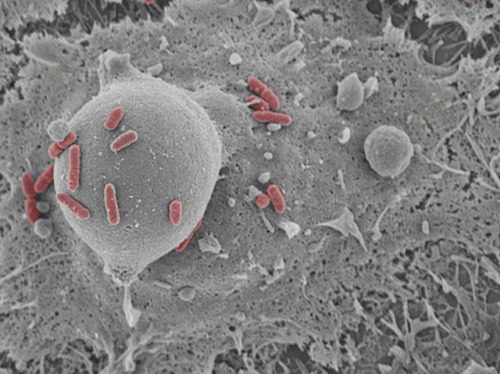
Contacts Meet Corneas
For those without 20/20 vision, contact lenses offer greater freedom than glasses. But there is a downside, the risk of infection as harmful bacteria, such as Enterobacteriaceae, are delivered via the lenses into the eye. These bacteria cause infection by first penetrating through the surface of the cornea, the epithelium, to reach its underlying tissue or stroma. Researchers investigate how by infecting human corneal epithelial cells in a dish with the Enterobacteriaceae, Serratia marcescens. Using a variety of techniques, including scanning electron microscopy of the infected corneal epithelial cells (pictured), they found S. marcescens (purple) caused shape changes, such as spherical blebs, in line with the rapid cell death they also detected. Mutating genes in S. marcescens to impair its secretion of bacterial toxins called cytolysins uncovered a series of proteins required to bring about corneal damage. With this model, researchers can now dig deeper into the pathology of these infections.
Written by Lux Fatimathas
- Image from work by Kimberly M. Brothers and Jake D. Callaghan, and colleagues
- Department of Ophthalmology, University of Pittsburgh, Pittsburgh, PA USA
- Image originally published under a Creative Commons Licence (BY 4.0)
- Published in PLOS Pathogens, June 2019
You can also follow BPoD on Instagram, Twitter and Facebook
Archive link





Комментариев нет:
Отправить комментарий